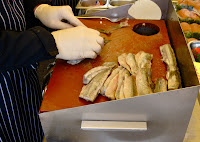Now that corn has reappeared in the farmers' markets, it's time to grill, baby, grill.
Boiled corn slathered with sweet butter and seasoned with sea salt and pepper is delicious. So too is grilled corn where olive oil replaces butter. Lightly browned, the kernels caramelize, adding sweetness and the hint of smoke.
Make extra, so the kernels can be removed and used in green salads, salsas, and--my favorite--pastas.

Tuscan or black kale is widely available in the farmers' markets in large, inexpensive bunches.
Adding in mushrooms, onions, garlic, a pat of butter and you're ready to enjoy a delicious lunch or dinner that needs little more than a simple romaine or arugula salad, a glass of wine or an ice cold beer, and you'll have a memorable meal with no more effort and time than it would take to order take out.
Pasta with Grilled Corn and Black Kale
Yield: 4 servings
Time: 30 minutes
Ingredients
2 ears of corn, husk and silks removed, washed

2 links, Italian sausage, washed (optional)
1 medium yellow onion, washed, skin removed, root end and top cut off and discarded, roughly chopped
2 garlic cloves, skins removed, finely chopped
1/2 pound shiitake or brown mushrooms, washed, dried, sliced
1 bunch Tuscan or black kale, washed, center stem removed, leaves roughly chopped1/2 box DeCecco pasta, gnocchi, penne, spaghetti, or bowties
1 tablespoon sweet butter
1 cup pasta water
1/4 cup olive oil
Sea salt and black pepper
Grated Parmesan or Romano cheese
Method

If a grill is not available, preheat the oven to 350 degrees. Pour the olive oil on a flat plate. Season with sea salt and pepper. Roll the corn through the seasoned oil to coat. Put on the grill or into the oven, turning every 5 minutes to prevent burning.
Do the same with the Italian sausage. Roll in the seasoned olive oil and grill or roast. For vegetarians, don't bother with the sausage.
While the corn and sausage are cooking, put a large pot of water on a high flame, seasoned with 2 tablespoons of kosher or sea salt. Don't use ordinary table salt which has a metallic flavor.
While the pasta water is heating, saute the onions, garlic, mushrooms, and kale until softened. If you want the kale more pliable, add 1/4 cup of water and braise for 5 minutes on a medium-high flame.
Put the pasta into the boiling water and stir every couple of minutes to prevent sticking. Use the whole box if you want more pasta.
Cut the kernels off the corn and discard the cobs. Finely chop or cut into rounds the Italian sausage. Add to the kale, together with the sweet butter. Toss well.
Taste the pasta. Drain and reserve 1 cup of pasta water. Put the pasta back in the still warm pot, drizzle with olive oil and season with sea salt and pepper. Toss well. Set aside.
Add 1/4 cup of the pasta water to the vegetables and sausage. Stir well and taste. Adjust seasoning as desired. If more sauce is desired, add a little more of the pasta water.
Pour the cooked pasta into the saute, toss well, adding another 1/4 cup of pasta water. Serve in a large bowl, accompanied with freshly grated cheese.
Variations
Grill or roast a red pepper, discard the seeds and skin, finely chop, add 1/4 cup to the saute.
Add 2 tablespoons chopped, pitted green olives to the saute.
 . When our kids were young, they made an easy to make after-school snack. By adding toppings the quesadilla turns into a fiesta of flavors. Since the quesadilla cooks quickly in a trying pan, the toppings should be pre-cooked, much the same way they are on pizzas.
. When our kids were young, they made an easy to make after-school snack. By adding toppings the quesadilla turns into a fiesta of flavors. Since the quesadilla cooks quickly in a trying pan, the toppings should be pre-cooked, much the same way they are on pizzas.

























